In short:
- World on the verge of multiple climate tipping points, even if we reach Paris Climate Agreement goals.
- New York governor declares disaster emergency after polio found in wastewater.
- ‘Triple dip’ La Niña is on the way, bringing cold and snow to the US Northwest and drought to the south.
National Preparedness Month Challenge
Each Tuesday and Friday throughout September, the news roundups will feature a section of TP’s beginner’s checklist and introduce a conversation topic or a challenge. After reading the highlighted section in the roundup, follow the instructions, and join us on Discord to discuss and get support. Read the introductory post and the previous topic here.
Today’s topic: Get your home ready for two weeks of self-reliance
We start with the home because it’s where you spend most of your time and is usually the best place to make it through an emergency. Which is why governments give the standard “stay in your home!” advice during a crisis.
Home checklist summary:
Water: store 15 gallons of potable water per person (roughly 1 gallon per day) and have ways to treat dirty water via either a portable water filter or countertop water filter
Food: at least 23,000 calories per person (roughly 1,500 calories per day) of shelf-stable food that’s ready to eat or only needs boiling water to make; usually one or a mix of extra supermarket food you normally eat anyway or special prepper food that lasts forever
Fire: lighters, matches, and backup fire starters
Light: headlamps, flashlights, candles, lanterns
Heating and cooling: indoor-safe heaters, extra blankets, USB-powered fan
Shelter: a tarp (even a cheap one you find at a local store) comes in handy for improvised shelter, plugging holes in the house, and clearing debris
Medical: list of 145 prioritized home medical supplies
Hygiene: wet wipes, hand sanitizer, camp soap
Communication: either a one-way NOAA radio or a two-way ham radio (if you know how to use it)
Power: spare batteries and rechargers (your bug out bag will have a solar charger, but you can also get a second one for home)
Tools: axe, shovel, work gloves, wrench for your gas lines, zip ties, duct tape, etc.
Self defense: depends on personal views, may include body armor, firearms, pepper spray etc.
Cash: as much as you can reasonably afford to stash
Mental health: board games, favorite books, headphones, movies downloaded to a tablet, etc.
Documents: copy of deeds/titles, insurance policies, birth certificates, maps, pictures of family members, etc. in both physical and USB thumb drive forms
Local & emergency info: write down important contact numbers, know the location of the nearest hospitals, etc.
For the challenge:
1. Finish reading the getting your home ready short section, which includes the full checklist summary with links to other guides, product reviews, etc.
2. Here are some suggested challenges to work on over the next couple of days. Pick one or two:
- Talk with your family about what you would do if you didn’t have electricity, water, cooking or heating gas, communication, internet, 911, ambulances, and so on for a few days to weeks. Just talking about what you might do during those outages can help you see holes in your plans and areas of improvement.
- Try turning off the circuit breaker, water main, or gas line, or unplugging your WiFi router for 1, 2, or even 3 days and live off of your preps to simulate a disaster in which these utilities are not available.
- Do some cleaning and organize your home preps. Knowing where all your stuff is, how much you have, and checking on the condition like expiration dates and battery charge levels.
- Take a look at the Home checklist summary and pick a category or two that you will improve on over the next couple of days. Buy a new weather radio, inventory your first aid kit, or read up on how to start a fire, anything you’d like!
3. Join us on Discord anytime after 12 pm ET in the #national-preperadeness-month channel for discussions and community challenges.
Economy, food security, supply chain, energy
An impending railroad strike in the US could drive up prices at the grocery store and limit US grain exports to countries facing famine. 115,000 freight rail workers could walk out next week if they can’t reach a new contract with railroads, potentially shutting down a network that transports 20% of grain.
Shipping rates plunge as experts say the ‘unprecedented’ boom has peaked. Ocean shipping rates on major trade routes have fallen by more than half since the beginning of this year, a potential sign of easing inflation pressures and alleviating supply chain logjams.
More Americans are using buy now, pay later services for groceries.
Worsening droughts are driving premiums for US farmland with water access. Investors are basically “acquiring water first.”
The worst drought ‘in living memory’ is threatening Spain, the world’s olive oil supply.
Report: Russian war is actually reducing fossil fuel use. Russia’s invasion of Ukraine has accelerated clean energy investments and reduced coal and gas power use. While global power demand in the first half of 2022 grew by about 2.5% over the previous year, emissions fell by about 1% thanks to the drop in fossil fuel generation. Coal consumption by power plants dropped 1.2% and gas saw a small decline during the period, compared with a 17% jump in wind and solar output.
Finland will be self-sufficient in electricity within a year or two.
Tokyo plans to require that new homes have solar panels from 2025.
Climate change, environment, extreme weather
The White House released the Climate Mapping for Resilience and Adaptation website that will help communities understand real-time climate-related hazards in their area, analyze projected long-term exposure to those hazards, and identify federal funds to support climate resilience projects for their communities. Here’s NOAA’s press release.
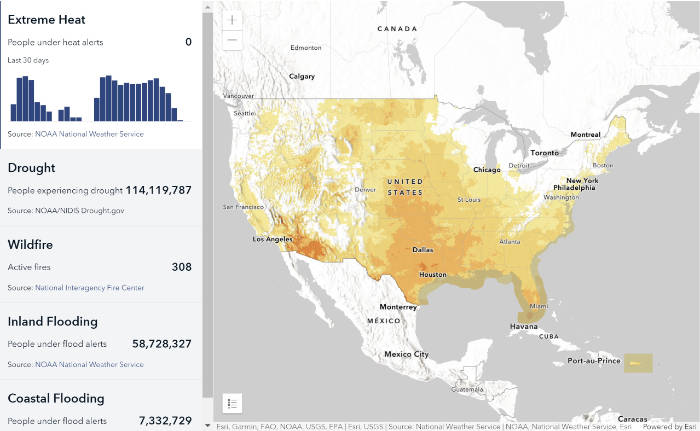
Study: World on the verge of multiple climate “tipping points” even if countries meet the more aggressive goals of the Paris Climate Agreement. Five dangerous tipping points may already have been passed. These include the collapse of Greenland’s ice cap, eventually producing a huge sea level rise, the collapse of a key current in the north Atlantic, disrupting rain upon which billions of people depend for food, and an abrupt melting of carbon-rich permafrost.
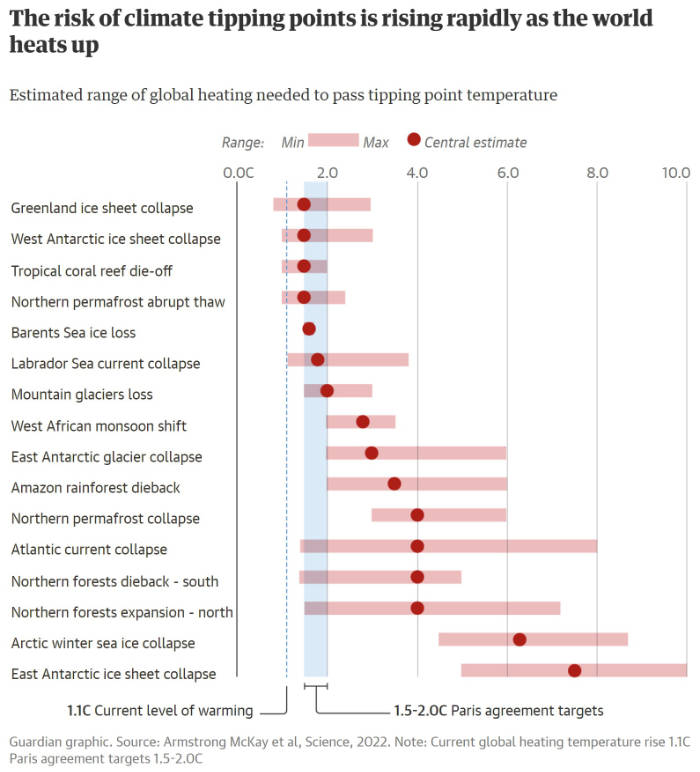
‘Triple dip’ La Niña is on the way—here is what it means for the US. A typical La Niña winter brings cold and snow to the Northwest and unusually dry conditions to most of the nation’s south. The Southeast and mid-Atlantic tend to see warmer-than-average temperatures, and New England and the Upper Midwest into New York tend to see colder-than-average temperatures. Although it’s not rare to see a La Niña lasting up to a year, this is the first “triple dip” La Niña of the century.
Saltwater intrusion threatens coastal agriculture on the Delmarva Peninsula and in the Carolinas. Thousands of acres are already unable to be farmed. Despite promising adaptation strategies, sea level rise is projected to drown tens of thousands of acres of farmland within the century. Most plants can only withstand 1 to 2 parts per thousand of salt. Any more than that, and they begin to wilt. Today, fields are measuring as high as 20 parts per thousand (seawater is 35). Here’s more about saltwater intrusion from the USGS.
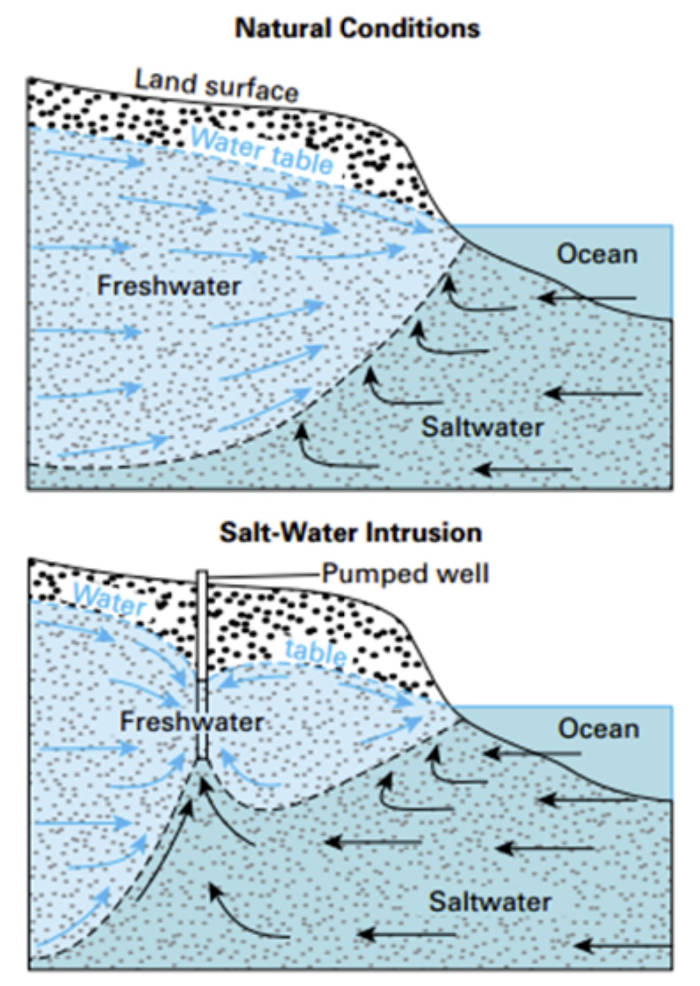
Analysis: Millions of US homes are being built in harm’s way. 55% of homes built so far this decade face fire risk, while 45% face drought risk. One of the areas seeing the biggest growth in new homes is the foothills of the Sierra Nevada Mountains. In Phoenix, builders are selling homes despite warnings that there may not be enough water (and people move in anyway).
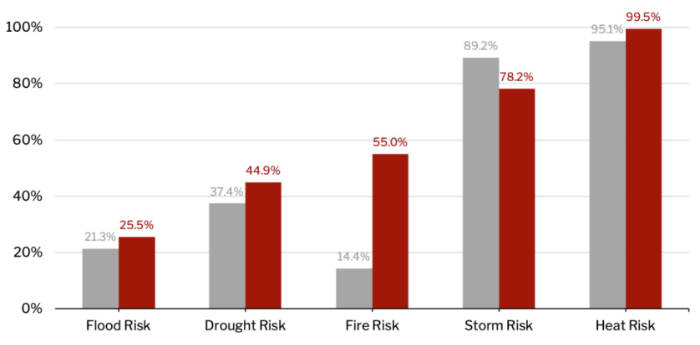
This summer in Europe was the hottest on record. Eastern Europe suffered the worst, though southwest parts of the continent also had “well above average” temperatures.
Temperature records were shattered across California and the west during a brutal September heatwave. Click on the map below for the full list:
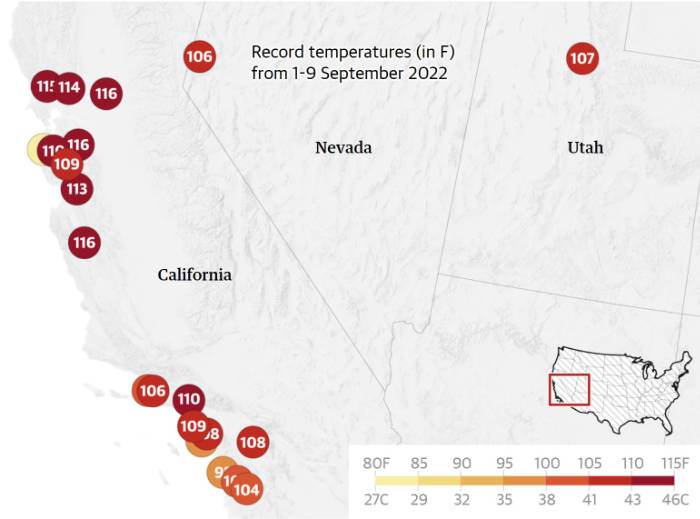
This was also the US’s third-hottest summer on record. Here’s NOAA’s summer recap of significant climate anomalies and events:
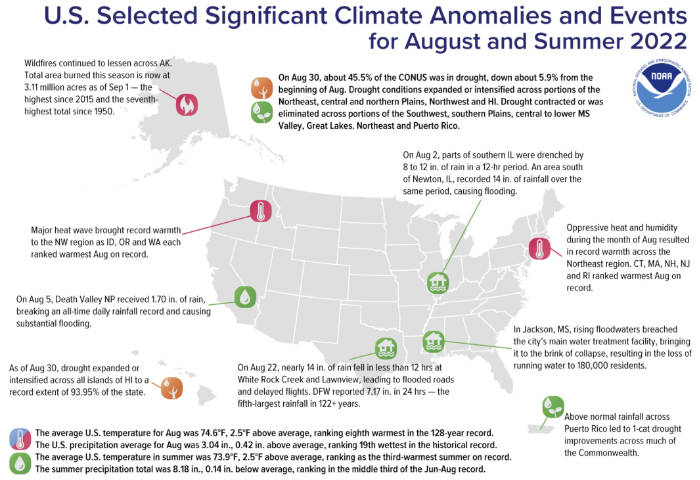
California is the first US state to begin ranking extreme heat wave events. The system will ensure Californians get properly notified of the severity of upcoming heat-related weather events. The law goes into effect in January 2023.
For those interested in climate activism:
Are you funding global warming every time you make a bank deposit? If you are with one of the major banks, your money is likely to be funding fossil fuels. Here’s how to find out more and consider making a switch.
Oil companies say they’re going green, but their investments tell another story. A new report finds that Big Oil spent $750 million on climate-friendly marketing last year.
It wasn’t just oil companies spreading climate denial. The electricity industry knew about the dangers of climate change 40 years ago. It denied them anyway.
Health
New York governor declares disaster emergency after polio found in wastewater. Polio is known to cause paralysis in children, and vaccination is the only way to prevent it. There is no cure for paralytic polio and no specific treatment. Read more about polio here.
Global monkeypox cases are still falling:
Another step in the right direction:
This is the 4th week in a row where monkeypox cases decline globally as we continue to see a clear downtrend in cases in the last month and a half.
5 weeks ago we recorded 6,887 cases vs 4,317 cases this week.
Let’s keep up the awareness! pic.twitter.com/smzddSC1Cu
— Monkeypoxtally (@Monkeypoxtally) September 11, 2022
Covid is on pace to remain the third-leading cause of death for Americans, with older and sicker people among the most vulnerable.
Children in Northern California are learning to cope with wildfire trauma. Increasingly frequent California wildfires are causing lasting psychological trauma for kids. In the long run, their emotional trauma can affect their physical health, potentially leading to chronic health problems, mental illness, and substance abuse. Wildfires disrupt routines, force people to move, and create instability for kids.
Scientists discovered how air pollution triggers lung cancer. In the study, researchers demonstrate that fine particulates in car fumes “wake up” dormant mutations in lung cells and tip them toward cancer. The study needs to be peer-reviewed.
The rest
Remembering the 9/11 attacks. Here’s the story of Will Jimeno, a Port Authority police officer who survived both Trade Center towers collapsing on him before being rescued 13 hours later without a single broken bone (long read).
Watch this young hero helping his classmate with a broken leg escape an earthquake:
A couple of quick hits from the geopolitics side—just to keep an eye on:
Russia is officially withdrawing from the Kharkiv area in northern Ukraine:
#Kharkiv Update:
The #Russian Ministry of Defense’s September 11 briefing map confirmed that Russian forces are withdrawing from settlements around Kharkiv City, from northern Kharkiv Oblast, and settlements on the western bank of the #Oskil River. /1https://t.co/c0t0qKlltX pic.twitter.com/9xAHIKHTDn
— Institute for the Study of War (@TheStudyofWar) September 12, 2022
Sanctions against Russia seem to be working: An internal document shows that Russia is facing a long and deep recession that might not be resolved until the end of the decade and an increasing brain drain from the IT sector.
North Korea declared itself a “nuclear state’. Under the new law, the military is required to “automatically” strike enemy forces, including their “point of provocation and command,” if Pyongyang’s leadership is attacked.
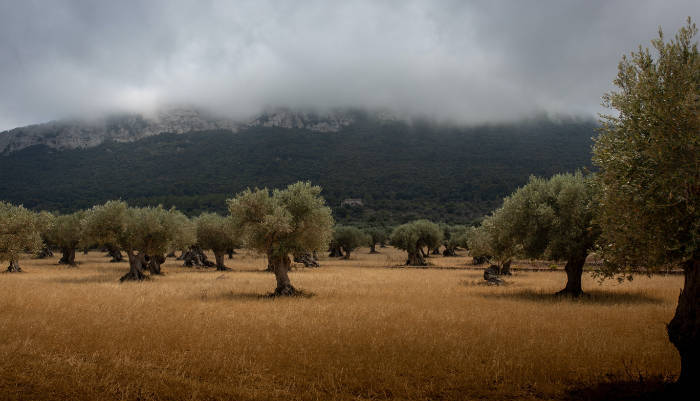
You are reporting the comment """ by on